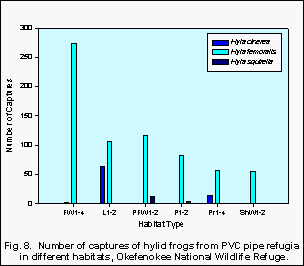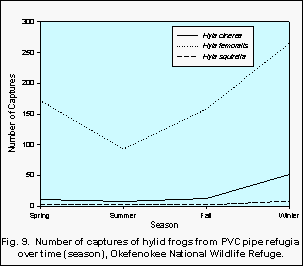|
Using Artificial Refugia to Sample Hylid Frogs in Okefenokee National Wildlife Refuge
Jennifer S. Staiger1, Lora L. Smith2, William J. Barichivich1, and C. Kenneth Dodd, Jr.1
1U.S.G.S. Florida Integrated Science Center, 7920 N.W. 71st St., Gainesville, FL 32653
2Joseph W. Jones Ecological Research Center, Rt. 2, Box 2324, Newton GA 31770
Presented at the Joint Meeting of the American Elasmobranch Society, American Society of Ichthyologists and Herpetologists, Herpetologists' League, and Society for the Study of Amphibians and Reptiles, Kansas City, Missouri. July 3-8, 2002
Abstract: As part of the Department of Interior's initiative to survey amphibian populations on federal lands, a long-term research and monitoring project is being conducted at the Okefenokee National Wildlife Refuge, Georgia. Many amphibian sampling techniques are being used, including artificial refugia (PVC pipes) targeting hylid frogs. Sixteen intensive survey sites were visited an average of 13 times during quarterly and special sampling periods from January 2001 to January 2002. Each intensive site has an array of 30 pipes in trees and/or in the ground, and represents one of six habitat types. Hyla femoralis, H. cinerea, and H. squirella used the refugia (692, 80, and 16 total captures, respectively), with the number of captures generally increasing over time. Recaptured individuals accounted for 46.4% of all H. femoralis caught, 38.7% of all H. cinerea, and 81.2% of H. squirella captures. The majority of H. femoralis captures occurred in forested wetland and pine flatwood sites (36.6% and 16.9%, respectively) whereas most H. cinerea captures were in lake sites (78.7%). All H. squirella captures were in pine flatwood and ephemeral pond sites (81.2% and 18.8%, respectively). Hyla femoralis was the only species found at least once at each site and during each sampling period.
|

